
Field Marshal and Count Jacob Pontusson De la Gardie was a statesman and a soldier of the Swedish Empire, and a Marshal from 1620 onward.
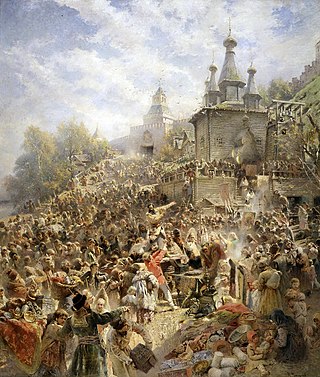
The Time of Troubles, also known as Smuta, was a period of political crisis in Russia which began in 1598 with the death of Feodor I, the last of the House of Rurik, and ended in 1613 with the accession of Michael I of the House of Romanov.

Marina Mniszech or Mnishek was a Polish noblewoman who was the tsaritsa of all Russia in May 1606 during the Time of Troubles as the wife of False Dmitry I. Following the death of her husband, she later married another imposter to the throne, False Dmitry II. A devout Catholic, she hoped to convert Russia's population to Catholicism.

False Dmitry II, historically known as Pseudo-Demetrius II and also called tushinsky vor, was the second of three pretenders to the Russian throne who claimed to be Tsarevich Dmitry Ivanovich, the youngest son of Ivan the Terrible, during the Time of Troubles. The real Dmitry had died under uncertain circumstances, most likely an assassination in 1591 at the age of nine at his widowed mother's appanage residence in Uglich.

The Polish–Muscovite War of 1605–1618, also known as the Polish–Russian War, Polish Intervention in Russia or the Dimitriads, was a conflict fought between the Polish–Lithuanian Commonwealth and the Tsardom of Russia from 1605 to 1618.
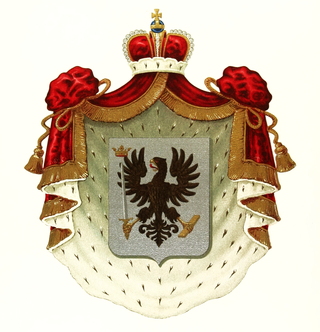
Prokopy Petrovich Lyapunov was a prominent 17th century Russian nobleman (dvoryanin), voivode of, allegedly, a Rurikid origin who practically became a head of Pereyaslavl-Ryazansky lands nobility in the end of 1590s; he took part in wars during power vacuum in succession crisis that happened in early 1598 in Tsardom as result of confusion about legitimate heir apparent following death of Feodor I, nobility infighting, war declared by Polish–Lithuanian Commonwealth (PLC) in 1605, and exhaustive Tatar raids; most famously he is remembered for organizing and leading the first unsuccessful uprising against occupation of Moscow of 1610 by PLC in April of 1611.

Lisowczyks or Lisowczycy was the name of an early 17th-century irregular unit of the Polish–Lithuanian light cavalry. The Lisowczycy took part in many battles across Europe and the historical accounts of the period characterized them as extremely agile, warlike, and bloodthirsty. Their numbers varied with time, from a few hundred to several thousand.
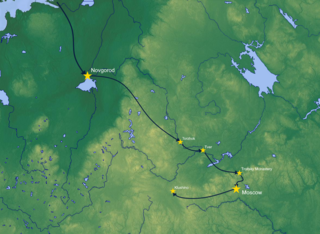
The De la Gardie campaign was a joint military campaign by the Tsardom of Russia and Sweden during the Polish–Muscovite War from April 1609 to June 1610.
Ivan Isayevich Bolotnikov headed a popular uprising in Russia in 1606–1607 known as the Bolotnikov Rebellion. The uprising formed part of the Time of Troubles in Russia.

The siege of the Troitsky monastery was an abortive attempt of the Polish–Lithuanian irregular army that acted in support of False Dmitry II to capture the Trinity Lavra of St. Sergius, north-east of Moscow. The siege lasted for 16 months, from 23 September 1608 until 12 January 1610.

Aleksander Józef Lisowski HNG was a Polish–Lithuanian noble (szlachcic), commander of a mercenary group that after his death adopted the name "Lisowczycy." His coat of arms was Jeż (Hedgehog).
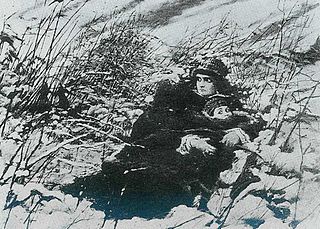
Ivan Dmitriyevich was the only son of False Dmitry II of Russia and his wife Marina Mniszech, daughter of Polish Voivode Jerzy Mniszech and his wife Jadwiga Tarło. He was a claimant to the throne of the Tsardom of Russia until his death at the age of three, in July 1614. He was killed right after his step-father, Ivan Zarutsky.

The Battle of Moscow was a series of two battles, which took place in Moscow, on September 1 and 3, 1612, during the Polish–Muscovite War (1605–18), and Time of Troubles. Forces of the Polish–Lithuanian Commonwealth were commanded by Field Hetman of Lithuania, Jan Karol Chodkiewicz, while the Russians were led by Dmitry Pozharsky. Battles ended in decisive Russian victories.
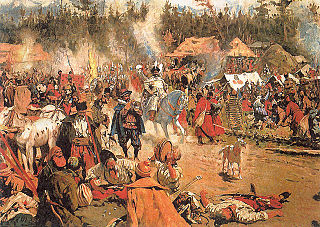
In the Battle of Zaraisk, during the Time of Troubles, on April 9, 1608, Colonel Alexander Lisovsky in service of False Dmitry II, defeated the army of Tsar Vasily IV under Zahariya Lyapunov and Ivan Khovansky.

In the Battle of Bolkhov on May 10–11, 1608, the troops of False Dmitry II managed to defeat the army of Tsar Vasily Shuisky.

The Battle of Kozelsk was the first victory of False Dmitry II against the government of Tsar Vasili IV Shiuski.

The Battle of Mozhaysk was a series of battles at the final stage of the Polish-Muscovite War (1605–1618) on the western approaches to Moscow. The battle is part of the Moscow campaign of Wladyslaw IV. During months of fighting, the Russian armies managed to maintain their combat capability and prevent the rapid seizure of Moscow. However, the threat of encirclement forced the Russian troops to retreat, opening the way for the enemy to the capital.

The Uprising of Bolotnikov, in Russian historiography called the Peasant War under the Leadership of Ivan Bolotnikov (Peasant Uprising), was a major peasant, Cossack, and noble uprising of 1606–1607 led by Ivan Bolotnikov and several other leaders. At the time of the highest point of the uprising (the Siege of Moscow in 1606), more than 70 cities in the south and center of Russia were under the control of the rebels.

Wigund-Jeronym Trubecki or Yuri Nikitich Trubetsky as he was called earlier in Muscovy was the Prince of Trubetsk from 1611 to 1634, preceded by Symeon Iwanowicz Perski Trubecki, succeeded by Piotr Trubecki, and Aleksander Trubecki. Yuri Nikitich Trubetsky was also a boyar and equestrian of False Dmitry II. After emigrating to Poland, and restoring The Principality of Trubetsk, he converted to Catholicism, and took the name Wigund-Jeronym Trubecki.

The Tushino Camp was the camp of False Dmitry II near the village of Tushino near Moscow, which from June 1608 to December 1609 served as the capital of this impostor, who, as a result, received the name "Tushino Thief". All those dissatisfied with the elected Tsar Vasily Shuisky, flocked to the Tushino Camp, which made it a shadow capital with its own state institutions, a patriarch, and so on. From December 1609 to March 1610, the Tushino Camp supported the Polish King Sigismund.
















